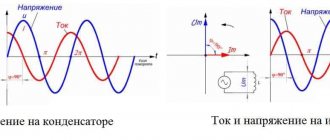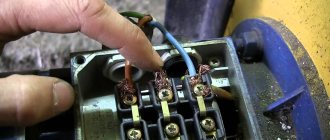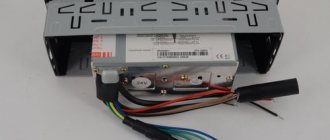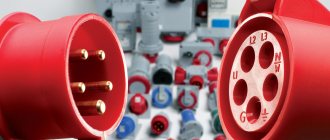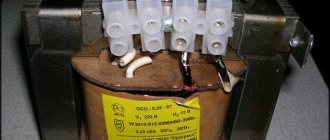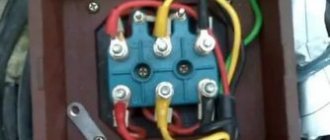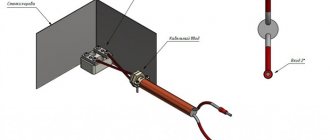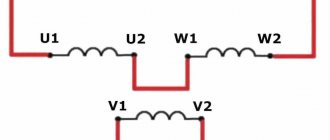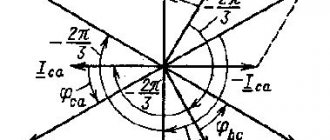Electricity is a serious and dangerous matter, but many jobs do not require high qualifications and can be done independently without the involvement of specialists. For example, you can connect an electric stove with only a vague understanding of electricity. Especially if the outlet is already installed. All that remains is to install a plug on the cord and connect it correctly to the connectors of the stove. The situation is worse if it is necessary to pull the line from the shield, but even here you can cope without help. Just remember that all work is carried out with the power supply turned off.
Connection diagram and methods
Electric household stoves are powerful equipment; the current they consume is about 40-50 A. This means that the electric stove must be connected to a dedicated power line. It must be powered directly from the apartment or house panel. Power is supplied through an RCD and a circuit breaker. The stove itself can be connected via a socket and plug (special power ones) and a terminal box. Also, the line from the machine can be directly connected to the input terminals on the rear wall.
Electric stove connection diagram
A more reliable connection is directly to the input terminals of the plate. In this case, there is a minimum number of contact points, which increases reliability. But this method is not entirely convenient: you can only turn off the power automatically. About the same problem occurs when using a terminal box, the only difference being that there are more connection points.
The most commonly used connection is a socket and plug. It's more convenient and familiar. Since the equipment is powerful, they use not ordinary household devices, but special ones, which are also called power devices - for their ability to withstand significant current loads.
Please note that when connecting powerful electrical equipment, grounding is required. Without it, you will be denied warranty repairs, and its absence is life-threatening, so it’s better not to take risks.
Electrical parameters and ratings of circuit breakers
As we found out, there should be separate RCDs and a circuit breaker in the electrical panel. Through them the phase is supplied to the socket. This pair can be replaced with a difavtomat. These are the same two devices, but in one case. The negative is taken from the common bus, passes through the RCD, and the grounding is taken from the corresponding bus.
The rating of the machine is selected based on the maximum current consumption. This data is in the electric stove's passport and is usually in the range of 40-50 A. In this range, the ratings come in large increments - 40 A, 50 A, 63 A. It is better to choose the nearest larger one - this way there is less chance of a false shutdown when operating at full power . That is, if the declared maximum current consumption is 42-43 A, still take a 50 A machine.
Electric stove connection diagram
On the other hand, you may never turn on all the burners and oven, and even at full power, and more powerful machines are significantly more expensive. It's up to you to choose.
The rating of the RCD is taken one step higher than that of the machine. If you decide to install a 50 A machine, then the RCD is required at 63 A, the leakage current is 30 mA.
RCD - residual current device
A residual current device (RCD) is a device that monitors leakage current in the electrical network. This device opens the contacts if the differential current value (i.e., the difference in current between the phase and neutral conductors) exceeds a critical level. The RCD includes elements designed to measure and compare currents passing through the electrical network and to open the circuit.
The residual current device is designed to prevent fires caused by worn-out wiring and to protect people from electric shock. It can only be installed together with a circuit breaker.
Residual current devices are characterized by the number of poles (2, 4), leakage current (electric shock -<30mA, universal =30mA and fire protection >30mA), as well as rated load current. All characteristics are indicated on the inside of the device.
Wire and its parameters
In recent years, when laying electrical wiring and connecting household appliances, copper conductors are most often used. Although they cost much more, they are more convenient to work with, and besides, copper requires a much smaller core diameter than when using aluminum conductors.
The conductor cross-section is selected depending on the type of network - 220 V or 380 V, the type of wiring (open/closed) as well as the current consumption or power of the equipment. Typically, copper conductors with a core of 4 mm (for line lengths up to 12 m) or 6 mm are used.
Conductor cross-section selection table
When choosing the type of cable to lay from the panel to the outlet, it is better to choose single-core conductors. Although they are more rigid, they are more reliable. To connect the stove itself (to which you will need to connect the power plug), you can choose a flexible stranded wire: a single-core wire in this case will be too inconvenient.
Theory
At industrial power plants, generators generate three-phase current and increase its voltage to tens and even hundreds of kilovolts. Electricity is supplied to consumers through power lines. But before this, the current enters the power transformer, which lowers the voltage to 380 V. From the distribution substation, the electricity enters the consumer network.
In a three-phase network, the current is supplied in such a way that all three are shifted relative to each other by 120 degrees. The voltage between phases is 380 V, and between phase and neutral 220 V (see Fig. 1). It is this voltage that is supplied to each apartment.
Rice. 1. Three-phase current structure
Since our goal is to obtain 380 V from a single-phase network, we will move on to methods of converting 220 V to 380.
How to connect an electric stove to a 220 V network
All the above diagrams were specifically for a single-phase 220 V network. To connect, you will need a three-wire cable, a three-pin power socket and a plug with a rated current of at least 32 A. Let’s say right away that connecting equipment from different brands is fundamentally no different. It doesn’t matter which stove you purchased - Electrolux, Gorenje, Bosh, Beko. Doesn't matter. The only difference is the different design of the covers that cover the terminal box on the housing and different methods of fastening it. Everything else is the same.
Connecting the cable to the electric stove
First, the cable selected for connection must be connected to the electric stove. On the rear panel, usually at the bottom left there is a terminal block to which the conductors are routed.
The terminal block to which the electrical cord must be connected
Nearby are connection diagrams for different networks.
Schematic illustration of connections for different networks
With a 220 V network, the diagram is on the far right. On the plate, contacts 1,2,3 should be connected by one jumper - this will be the phase (red or brown conductors), the second - contacts 4 and 5 - this is neutral or zero (blue or blue), the sixth contact is ground (green or yellow -green). Electrical plates usually come from the store with jumpers already installed, but it doesn’t hurt to check.
Connecting the cable to the electric stove
It is more correct and reliable to crimp the conductors with contact plates, and then connect them. This connection is more reliable, but often the conductors are simply twisted around the clamping screw and then tightened. In any case, it is better to follow the color coding - this way there is less chance of making a mistake.
Communications liner
It is necessary to take into account that the heating main must provide the required cross-section (the diameter must meet the technical requirements). And yet, the necessary flow of coolant through the fan heater must be ensured. If the diameter of the pipes and the temperature of the coolant are sufficient, but the speed of movement (flow) is very weak, this will negatively affect the thermal power of the device!
Also, think about how to supply power and control circuits. Calculate the required distances to purchase the required footage of electrical wire.
And one moment. Make sure that the wall (or ceiling) on which the fan heater will be mounted is of sufficient strength to withstand the load.
This is interesting: Are infrared heaters harmful to health or not - 5 facts: we describe in detail
Tags: machine, boiler, sconce, view, harm, engine, house, capacity, grounding, star, sign, cable, like, capacitor, magnet, installation, power, voltage, connection, principle, wire, manufacturer, start , , work, regulator, socket, row, garden, network, connection, diagram, ten, type, current, triangle, three-phase, , phase, photo, shield, electric motor, electrical panel
Connection to a three-phase 380 V network
In this case, an automatic machine and an RCD for a three-phase network are purchased; the wires must be five-core (the cross-section is determined using the same table, only the value must be looked at in the 380 V column). The plug and socket must also have five contacts.
The connection process itself will not differ in anything, only in the number of wires. The difference will be when connecting the wire to the output terminals of the electric stove. Only one jumper will be installed - on pins 5 and 6. All others are connected with separate conductors.
Connection diagram for an electric stove to a three-phase network
It is also necessary to monitor the position of “ground” and “neutral” (or they also say “zero”). The color matching of the conductors on the phases is not critical, but it is more convenient if they also match.
Electricity is a serious and dangerous matter, but many jobs do not require high qualifications and can be done independently without the involvement of specialists. For example, you can connect an electric stove with only a vague understanding of electricity. Especially if the outlet is already installed. All that remains is to install a plug on the cord and connect it correctly to the connectors of the stove. The situation is worse if it is necessary to pull the line from the shield, but even here you can cope without help. Just remember that all work is carried out with the power supply turned off.
How to protect yourself from zero loss
How to deal with this? There are several ways to protect yourself from increased voltage when the zero line breaks.
The first method is to reliably re-ground the neutral conductor. Looking ahead, I’ll say that this method is bad and harmful.
This method can be used in private homes. It doesn’t matter if you have single-phase or three-phase input. The most important thing is to make a high-quality grounding circuit.
After this, connect the neutral conductor busbar to this circuit with a separate conductor. In the event of a break in the neutral wire, the power supply to your household appliances will remain in balance and no major imbalance will occur.
The current will flow from the phase through the consumer resistance and go through the zero busbar and its conductor to the ground. And so on for all other phases.
A slight imbalance will of course be present here, but its magnitude will depend on the quality of your ground loop. However, this method of protection has one big drawback that negates all its advantages.
Of course, a grounding loop needs to be made, no one argues with that. The question is whether to connect it to the neutral conductor.
After all, if it is of high quality (10 Ohms or even 4 Ohms) only you have along the entire street, and a break in the neutral wire happens not near your house, but at the very beginning of the overhead line, then all your neighbors will immediately “sit” on this circuit.
In fact, the entire total current will go through your neutral conductor. If you set zero through a two-pole or four-pole circuit breaker, it will most likely break due to overload. Otherwise, expect a fire and melted wiring.
Therefore, a correctly assembled shield (an input circuit breaker selected for the load, grounding a copper conductor with a cross-section of at least 10 mm2) is the key to your safety.
Another disadvantage of such “circuit protection” is the danger of getting energized yourself. Let's say you made a great outline a few years ago.
But due to the presence of salts in the soil, it gradually rotted, and you don’t even know about it.
As a result, with the next neutral break, all grounded electrical equipment in your home will be energized. There is no land anymore. And the phase potential will begin to flow through the instrument housings.
I went to open the refrigerator and got an electric shock; I went into the shower and got electrified.
Therefore, it is more reliable and safe to use another method.
Connection diagram and methods
Electric household stoves are powerful equipment; the current they consume is about 40-50 A. This means that the electric stove must be connected to a dedicated power line. It must be powered directly from the apartment or house panel. Power is supplied through an RCD and a circuit breaker. The stove itself can be connected via a socket and plug (special power ones) and a terminal box. Also, the line from the machine can be directly connected to the input terminals on the rear wall.
Electric stove connection diagram
A more reliable connection is directly to the input terminals of the plate. In this case, there is a minimum number of contact points, which increases reliability. But this method is not entirely convenient: you can only turn off the power automatically. About the same problem occurs when using a terminal box, the only difference being that there are more connection points.
The most commonly used connection is a socket and plug. It's more convenient and familiar. Since the equipment is powerful, they use not ordinary household devices, but special ones, which are also called power devices - for their ability to withstand significant current loads.
Please note that when connecting powerful electrical equipment, grounding is required. Without it, you will be denied warranty repairs, and its absence is life-threatening, so it’s better not to take risks.
Electrical parameters and ratings of circuit breakers
As we found out, there should be separate RCDs and a circuit breaker in the electrical panel. Through them the phase is supplied to the socket. This pair can be replaced with a difavtomat. These are the same two devices, but in one case. The negative is taken from the common bus, passes through the RCD, and the grounding is taken from the corresponding bus.
The rating of the machine is selected based on the maximum current consumption. This data is in the electric stove's passport and is usually in the range of 40-50 A. In this range, the ratings come in large increments - 40 A, 50 A, 63 A. It is better to choose the nearest larger one - this way there is less chance of a false shutdown when operating at full power . That is, if the declared maximum current consumption is 42-43 A, still take a 50 A machine.
Electric stove connection diagram
Wire and its parameters
In recent years, when laying electrical wiring and connecting household appliances, copper conductors are most often used. Although they cost much more, they are more convenient to work with, and besides, copper requires a much smaller core diameter than when using aluminum conductors.
The conductor cross-section is selected depending on the type of network - 220 V or 380 V, the type of wiring (open/closed) as well as the current consumption or power of the equipment. Typically, copper conductors with a core of 4 mm (for line lengths up to 12 m) or 6 mm are used.
Conductor cross-section selection table
When choosing the type of cable to lay from the panel to the outlet, it is better to choose single-core conductors. Although they are more rigid, they are more reliable. To connect the stove itself (to which you will need to connect the power plug), you can choose a flexible stranded wire: a single-core wire in this case will be too inconvenient.
Theory
At industrial power plants, generators generate three-phase current and increase its voltage to tens and even hundreds of kilovolts. Electricity is supplied to consumers through power lines. But before this, the current enters the power transformer, which lowers the voltage to 380 V. From the distribution substation, the electricity enters the consumer network.
In a three-phase network, the current is supplied in such a way that all three are shifted relative to each other by 120 degrees. The voltage between phases is 380 V, and between phase and neutral 220 V (see Fig. 1). It is this voltage that is supplied to each apartment.
Rice. 1. Three-phase current structure
Since our goal is to obtain 380 V from a single-phase network, we will move on to methods of converting 220 V to 380.
How to connect an electric stove to a 220 V network
All the above diagrams were specifically for a single-phase 220 V network. To connect, you will need a three-wire cable, a three-pin power socket and a plug with a rated current of at least 32 A. Let’s say right away that connecting equipment from different brands is fundamentally no different. It doesn’t matter which stove you purchased - Electrolux, Gorenje, Bosh, Beko. Doesn't matter. The only difference is the different design of the covers that cover the terminal box on the housing and different methods of fastening it. Everything else is the same.
Connecting the cable to the electric stove
First, the cable selected for connection must be connected to the electric stove. On the rear panel, usually at the bottom left there is a terminal block to which the conductors are routed.
The terminal block to which the electrical cord must be connected
Nearby are connection diagrams for different networks.
Schematic illustration of connections for different networks
With a 220 V network, the diagram is on the far right. On the plate, contacts 1,2,3 should be connected by one jumper - this will be the phase (red or brown conductors), the second - contacts 4 and 5 - this is neutral or zero (blue or blue), the sixth contact is ground (green or yellow -green). Electrical plates usually come from the store with jumpers already installed, but it doesn’t hurt to check.
Connecting the cable to the electric stove
It is more correct and reliable to crimp the conductors with contact plates, and then connect them. This connection is more reliable, but often the conductors are simply twisted around the clamping screw and then tightened. In any case, it is better to follow the color coding - this way there is less chance of making a mistake.
It is better to terminate the conductors with contact plates
Plug installation
Next, a plug is connected to the cable. The power plug is collapsible. Unscrew the two mounting screws and remove the cover with contacts. The fixing bar holding the cable is also removed. The protective insulation is removed from the edge of the flexible cable (about 5-6 cm), the conductors are straightened, their ends are also stripped of insulation by about 1.5-2 cm. The cut end of the cable is inserted into the plug body.
This is what the plug for connecting an electric stove looks like
The clamping screws on the contacts are loosened, the conductors, if they are multi-core, are twisted into a bundle. These flagella are twisted around the contacts and tightened with clamping screws.
The distribution of conductors matters and they must be connected carefully. The top contact of the plug is usually labeled - the “ground” wire (green) is connected here. When connecting a socket, you need to apply ground to a similar connector.
Connecting the wire to the electric stove
The other two contacts are “phase” and “zero”. Where to apply which one is not important, but when connecting the socket, the “phase” must fall on the “phase”, the “zero” must fall on the “zero”. Otherwise there will be a short circuit. So before turning it on, be sure to double-check that the wires (phase and neutral) are screwed in correctly.
How to determine the phase in an installed socket
If you already had an electric stove before, and there is a socket, you need to find in it where the grounding, phase and neutral are located and connect the wires in the plug accordingly. The easiest way to determine this is to use a voltage indicator in the form of a screwdriver. It works simply - install the indicator in the place of the expected phase, and look at the LED mounted in the housing. If it lights up, then there is voltage and this is a phase. If there is no voltage, the LED does not light up, and this is zero.
The ground is even easier to determine: is the contact at the top or bottom.
Features of the 380V outlet
Takel Power Socket Fixed Internal 380 Volt
Power cable connectors are designed for harsh technical conditions. The industrial plug and heavy-duty 380V socket are protected by a durable housing that can withstand minor impacts. Simplicity of connection, strong plastic and high throughput allow the connection structure to be used outdoors, in industrial workshops or during construction work. The product is subject to increased safety requirements.
The contacts have a large contact area, which reduces the load and eliminates possible overheating. Each cable clamp is secured with a screw connection that holds the wire in its seat. The copper construction is protected from corrosion and is also resistant to oxide film growth.
The clamp holds the cable securely, preventing breakage. Special grooves ensure a strong connection and eliminate backlash. The contacts have different diameters and are located at their own angles. The connection provides protection against unbalanced connection, which prevents short circuits.
With high voltage, the risk of arcing increases. Each 380 socket has mechanical or automatic protection. The device can stop power supply until removed. The solution reduces the risk of equipment failure or skin burns.
The plastic is resistant to overheating, non-flammable and can withstand direct sunlight. Protection from dust and moisture is provided, which will preserve the quality of parts and make work safe.
The 380 volt electrical outlet is manufactured in accordance with the IP 44 or IP67 standard.
Connection to a three-phase 380 V network
In this case, an automatic machine and an RCD for a three-phase network are purchased; the wires must be five-core (the cross-section is determined using the same table, only the value must be looked at in the 380 V column). The plug and socket must also have five contacts.
The connection process itself will not differ in anything, only in the number of wires. The difference will be when connecting the wire to the output terminals of the electric stove. Only one jumper will be installed - on pins 5 and 6. All others are connected with separate conductors.
Connection diagram for an electric stove to a three-phase network
It is also necessary to monitor the position of “ground” and “neutral” (or they also say “zero”). The color matching of the conductors on the phases is not critical, but it is more convenient if they also match.
How to connect an electric stove to a 220 Volt outlet
An electric stove using a 220 Volt network can be easily connected to almost any apartment and private house. Also, given the very high consumption of electricity, all modern electric stoves and hobs have the ability to connect not only to a 220 Volt network, but also to a 360 Volt network. And most often, a single-phase connection is used. This is the standard circuit that usually comes with the kit, already assembled.
Diagram of the distribution of wires in the electric stove plug
The first three contacts (L1 L2 L3) are connected together (with a jumper, for example), and a phase is connected to them. We connect zero to pins 4 and 5, respectively. The last 6th contact, as you probably already guessed, is connected to grounding.
Typically, the contacts and wires are always colored the same. The standard colors are phase (+) red, black or brown, zero blue, and ground yellow-green, but it’s better, just in case, to look at the instructions and make sure the connection is correct.
It happens that there are not 3, but 5 wires. In this case, the pairs are zero and phase, and the one is ground.
When connecting an electric stove to a single-phase network, you don’t have to worry about mixing up the phase and neutral connections, nothing bad will happen and everything will work. However, DO NOT CONFUSE the phase with the grounding - it will constantly knock out “plugs”, and in the worst case, you can burn the machine or panel.
It is for this purpose that the grounding wire and contact are located separately, so as not to be confused, and the design of the socket with grounding allows you to insert the plug in only one position.
Let's take a closer look at the most common sockets used to connect electric stoves.
- RS 32 socket, usually Russian or Ukrainian production. The grounding contact is located on top and is turned 90 degrees relative to phase and zero, so that it cannot be plugged in differently. As in the photo - phase (brown wires) to the right contact, zero (with a blue stripe) to the left, although as I already said, if you switch places, it’s okay.
- Socket for electric stove, made in Belarus. The contacts are located at an angle, which also eliminates the possibility of incorrect connection. The ground, as usual with domestic manufacturers, is the top contact.
- Legrand socket2P+E, 32A. A beautiful, reliable outlet, perfect for a good repair (although whoever looks at it is behind the stove). It differs from ours and the CIS in that the grounding contact is at the bottom of the socket and has a rectangular shape, while the phase and neutral are round.
What is important to know
In a three-phase network, all three phases have a shift of 120 degrees. If it were necessary to convert three-phase 220 Volts to 380V, or single-phase 220V to the same, but with a voltage of 380V, then this can be done very simply using a conventional step-up transformer. In this problem, it is necessary not just to increase the voltage, but to obtain a full-fledged three-phase network from a single-phase one.
There are three main ways in which this manipulation can be done:
- using an electronic converter (inverter);
- by connecting two additional phases;
- due to the use of a three-phase transformer, but the power is still reduced.
Before converting the mains voltage, you need to consider whether it is possible to connect the motor to a standard single-phase network without loss of power. First you need to look at the plate on the engine itself, some of them are designed for both of these voltages, as shown in the first photo. You just need a capacitor for starting.
The second plate shows that the machine is designed exclusively for star connection of windings and a voltage of 380 Volts:
You can, of course, disassemble the engine and find the ends of the windings, but this is already problematic. Let us dwell in more detail on the creation of a high-quality three-phase network of 380 V from 220.
